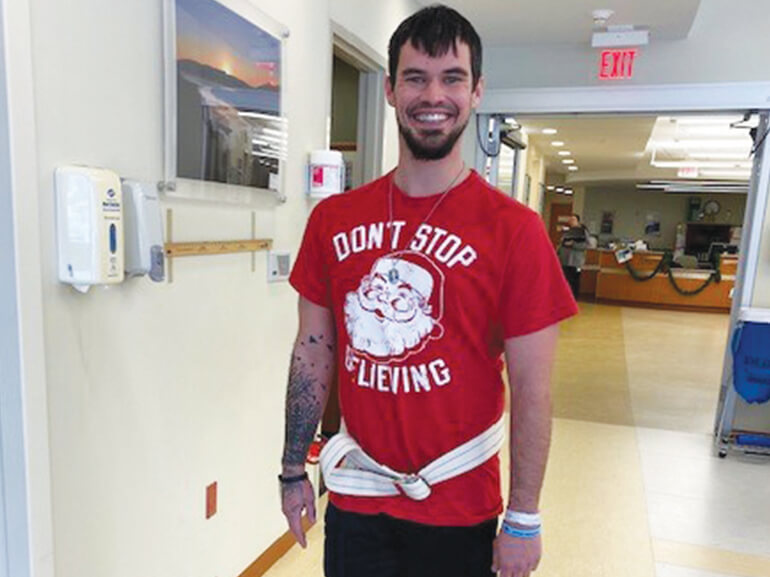Chris' story

Chris Crocker, a roofer by profession, enjoyed the physical labor and the opportunity to be outdoors. But on August 22, 2019, everything changed. The 29-year-old was installing a metal roof as it started to rain. Chris lost his footing and fell 20 feet to the ground.
An ambulance rushed him to the emergency room, where scans revealed Chris had sustained a traumatic spinal cord injury that left him with no movement or sensation in his legs. He had surgery to help relieve pressure on the spinal cord and nerves. His left leg was also fractured, and he would be unable to put weight on it for at least three months.
Seven days after his accident, Chris was admitted to SSM Health Rehabilitation Hospital in Bridgeton, Missouri, to begin his recovery.
Chris was initially admitted for intensive occupational and physical therapies to help restore his strength and ability to perform every day activities. Unable to stand or walk, Chris learned to use a wheelchair for all aspects of mobility. He worked on advancing his skills to navigate curbs and other potential obstacles he would face in the community. He also learned a range of strategies and how to use adaptive equipment to increase his independence, such as using a waterproof chair to shower.
“It [the accident] changed my life,” Chris said. “I had to relearn how to do everything.”
Throughout his stay, he maintained a positive outlook. Chris grew stronger every day and, toward the end of his stay, began to show signs of movement in his right leg.
He was discharged in mid-September and was able to move about in his wheelchair and complete most daily activities on his own. The most exciting part was that with function returning to his legs, Chris and his medical team were cautiously optimistic that he might walk again.
By mid-December, Chris was able to place weight on his left leg, and he was readmitted to SSM Health Rehabilitation Hospital – Bridgeton. Chris said that he returned because everyone at the hospital is “top notch and really nice.”
As he began the next phase of his rehabilitation, Chris managed to walk 15 feet with the assistance of two people. By the end of the first week of therapy, Chris was walking 165 feet with minimal assistance from one person. At the end of week two, he was walking 300 feet with just a cane. Therapy focused on extensive training to strengthen his leg muscles and increase his balance. This improved his ability to stand from a seated position in the wheelchair. He worked on standing to shower, get dressed and at the kitchen counter to cook. But his main goal was to be able to get up and down from the floor to play with his children.
To further support his progress, Chris’s therapy team added robotic gait training, using the Hocoma Lokomat. This device supports an individual’s body weight using a special harness system and moves the legs in a walking pattern on a treadmill. The repetitive movement helps to retrain the muscles and nerves to improve gait. Chris was quickly showing an improved level of independence with all mobility. In addition to tolerating decreased levels of body weight support needed for walking in the Lokomat, he was walking longer distances at faster treadmill speeds. Chris said robotics training had the biggest impact on his ability to walk again.
“I wasn’t afraid I was going to fall. (The suit) helped me with the walking motion,” he said.
Chris was discharged on December 20 — just in time to celebrate the holidays with his family, including his dog. He’s now looking forward to returning to work, grateful to be able to do so. His advice to anyone in a similar situation is simple: “Don’t quit.”